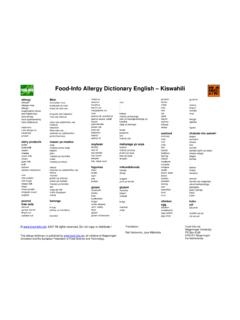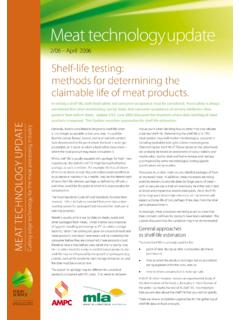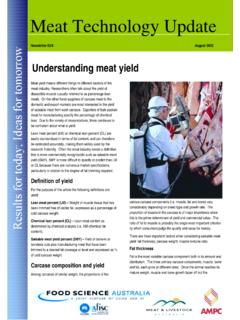Transcription of Guidelines on air handling in the food industry
1 Guidelines on airhandling in the foodindustryThis article is an extended summary of the reportprepared in consultation with the members of the AirHandling Subgroup of the European Hygienic Engineering& Design Group (EHEDG) in March 2005. This is the10th in the series published in TIFS. The full reportprepared by K. Brown (Chairman), K. Aichinger, , A. Fahldieck, M. Freund, Germain, , I. Klemetti, N. Lacroix, S. Nakatani, G. Sasia, , Ph. Van Beek, S. Wray, is available from CCFRA Information about EHEDG can befound The production of EHEDGG uidelines is supported by the European Commissionunder the Quality of Life Programme, Project HYFOMA(QLK1-CT-2000-01359).IntroductionT he quality of air within factory buildings is controlledby many food manufacturers. Environmental air of aspecified quality (temperature, humidity and particleconcentration) and quantity (fresh air volume) is requiredfor the comfort and safety of employees.
2 For themanufacture of some products, it is necessary to imposeadditional controls on environmental air quality to reducethe possibility of contamination. Also, process air thatcomes in contact with food must be controlled properties of air, especially temperatureand humidity, may be used to prevent or reduce the growthrate of some micro-organisms in manufacturing and storageareas. The particle content dust and micro-organisms can also be controlled to limit the risk of productcontamination and hence contribute to safe food manufac-ture. Airborne contaminants are commonly removed byfiltration. The extent and rate of their removal can beadjusted according to the acceptable risks of productcontamination and also in response to any need for of guidelinesThese Guidelines are intended to assist food producers inthe design, selection, installation, and operation of airhandling systems.
3 Information is provided on the role of airsystems in maintaining and achieving microbiologicalstandards in food products. The Guidelines cover the choiceof systems, filtration types, system concepts, construction,maintenance, sanitation, testing, commissioning, validationand system monitoring. The Guidelines are not intended tobe a specification for construction of any item of equipmentinstalled as part of an air handling system. Each installationneeds to take account of local requirements and specialist airquality engineers should be consulted, to assist in the designand operation of the terminology used in this document isdemonstrated inFig. of air handling systemsProperly designed air handling systems control airborneparticulates and odours and minimise the risks to productsfrom airborne contamination by infectious pathogens ( ,Listeria,E. coli) and toxigenic pathogens ( aureusand clostridia) and spoilage micro-organisms ( yeast, moulds, pseudomonads and lacticacid bacteria).
4 In addition to control of airborne contamination, thefollowing variables are important to the specification of theair handling system: Temperature:temperatures below 138C should only beused when higher temperatures would be prejudicial tofood safety. Air distribution:to remove the heat imposed by theprocesses and people, to provide sufficient fresh air,prevent the ingress of airborne contamination and avoidregions of stagnant that affect the choice of air changes are asfollows: Volume of the space; Cooling capacity (removal of heat); Number of people (fresh air requirement); Temperature differences with adjoining work areas;0924-2244/$ - see front matterq2006 Elsevier Ltd. All rights in food Science & Technology 17 (2006) 331 336 EHEDG Update Humidity and odour control; Over pressure required; Air quality of the air flow rate, care needs to be takenthat the air is moving from high to low care areas or fromlow to higher dust loading of airborne microbial contaminationIn factories micro-organisms can be dispersed byaerosols consisting of particles dispersed in air.
5 Theparticles are solid or liquid and may have micro-organismsinside or on their surfaces. Mould and bacterial spores areoften airborne without being attached to dust or may enter food production areas via drains,doorways and hatches, disinfection tunnels and compressedair supplies, or may be generated within the food productionarea during cleaning and washing operations. Other sourcesof airborne contamination include: Raw materials; Packaging; People; Poorly designed, cleaned or maintained air handlingsystems; Moving or rotating effectiveness of control of the main types ofmicrobial contamination by environmental air handling issummarised inTable operational statesNormal productionIn the normal operational state, the air handling systemwill correctly distribute fully conditioned ( filtered,controlled temperature and humidity) air into the productionarea at the required rate and recirculate it (typically 85%recirculation and 15% exhaust/replenishment) through air handling system may need an additionaloperational state during factory cleaning, which will inputfiltered fresh air into the production area via the ducting, tomaintain the overpressure and protect the filters frommoisture damage, but will extract moisture-laden airdirectly to exhaust without re-circulation.
6 If there is noextract system, then aerosols should be allowed to settle andappropriate drying and disinfection periods of non-production, if necessary, the airsystem will input filtered or fully conditioned air into theproduction area, to maintain a specified over pressure ortemperature. This air can be recirculated at a very low rate,depending on leakage from the area, the heat load or lossfrom the system, ensuring that a positive pressure air handling system should be designed to allow forservice, filter changes, with a minimum of downtimeFig. 1. Standardised terminology for environmental air at different stages. (Source:Unless otherwise stated, figures and tables reproducedcourtesy of CCFRA.)EHEDG Update / Trends in food Science & Technology 17 (2006) 331 336332and ducting/production area contamination. The systemdesign (for example, duplication of some equipment orducts) may allow maintenance or repair without may be a need for a special start-up procedure aftermaintenance, building work or other stoppages to removeparticles and microbial contaminants from the air handlingsystem and environment or to reduce the temperature of thework design conceptsIt is important at the outset to define the risk category ofproduct to be manufactured in the controlled area.
7 This willdetermine the level of air filtration required and influencethe design of the air handling system. It is essential toinclude in the design items that may have an influence on thecontrolled area, such as doors, inlet/outlet hatches risk categoriesFood factories make products for a range of customeruses and storage conditions. Products range from low risk ambient stable, packaged foods or those assured of a fullheat treatment by the customer, to high-risk chilled andother ready-to-eat foods. The growth, survival or dispersionof hazardous micro-organisms may be influenced by the airsystem, which should: slow or prevent their growth in the manufacturingenvironment ( by low temperature and/or humidity); prevent their ingress ( by overpressure); remove particles whichmay carry them ( byfiltration); minimise cross-contamination ( by correctlydesigned air delivery systems); if possible move the aerosols away from product usingdirectional air; not act as a source of contamination (hygienic design andoperation).
8 Medium risk or high care areasFor some types of products and processes such assandwiches or salads, air quality is an important contributorto the overall product microbiological safety and relating to physical separation, personnel,materials, equipment and the environment are managedwith the aim ofminimisingcontamination. The air supplyand handling system is likely to play a significant role incontrolling risk areasMinimum-risk manufacture of some products, likecooked meat, requires that the stages of production directlyaffecting the microbiological quality of the final product aredone in a physically separated area and that a high standardof hygiene relating to personnel, materials, equipment andenvironment are managed with the aim ofpreventingcontamination. In this type of manufacturing area, the airsupply and handling system is likely to play a critical role incontrolling microbiological systemsAseptic filling systems are used for products that areusually microbiologically ambient stable in the final sealedpackage.
9 Aseptic systems are required to operate to veryhigh standards of microbiological safety to ensure minimumprobability that product units will be contaminated. The airsupplied should be filtered and equipment must be capableof being sterilised after each operating cycle, or when theintegrity of the sterile zone is lost. Before production, the airTable 1. Effectiveness of control by air systems of main types of contaminationSource ofcontaminationMechanism of distributionEffectiveness of controlby air systemRisk to productsafetyRaw materials ( or raw product)Micro-organisms carried on surfacesLowMedium to highPersonnelOn feet, clothing or poor personal hygieneLowMedium to highTrafficTrolleys and fork lift truck wheelsLowMedium to highAirborneFresh airHighMediumParticles of dust or powderHighMediumAerosols from spray, splashesMediumHighPneumatic transport, overpressure, gas blanketing ofproductHighHighCondensationContactHigh (drying capacity)HighSurfacesSurface to surface contactLowHighCleaning operationsAerosols from hosing, brushing, vacuumingHigh (removal rate andcontrol of dispersion)
10 HighEquipmentBlow lines, exhaust from pneumatic systems andcompressed air linesHighMedium to highBuildingsLeaking roofs, badly fitting windows or doors, poordesign, construction or maintenanceLowMedium to highEHEDG Update / Trends in food Science & Technology 17 (2006) 331 336333system may be decontaminated using chemical sterilantwhich must be removed before production volume of sterile air delivered by the air supplysystem must be sufficient to maintain an adequate over-pressure and outflow of air, usually specified by themanufacturer of the aseptic system. The air supply systemmust be adequate for all operating conditions, including, forexample, draught, and movements in the operating area andopening of access to an aseptic room which may enclose filtrationAir filter selection for environmental and process use is acritical part of ensuring final air quality in a food processingenvironment.






